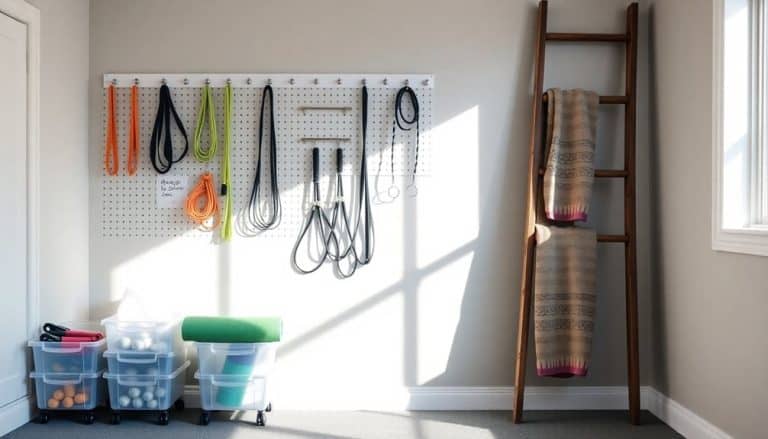This website contains affiliate links. Some products are gifted by the brand to test. As an Amazon Associate, I earn from qualifying purchases. The content on this website was created with the help of AI.
To optimize your seasonal clothing organization in 2024, you’ll need a smart, tech-enabled system. Start by creating climate-adaptive zones with programmable dehumidifiers and temperature controls (68-72°F for current wear, 55-60°F for storage). Use AI-powered compression units and RFID-enabled hangers to track your wardrobe digitally, while motion-activated LED strips guarantee energy-efficient access. Implement a digital inventory system to monitor wear frequency and maintenance needs. Roll clothes instead of folding, and utilize vacuum storage bags for bulky items. The combination of smart technology and proper preservation techniques will transform your seasonal wardrobe management into a seamless experience.
Key Takeaways
- Implement smart storage solutions with tech-enabled rods and RFID hangers to track and organize seasonal clothing efficiently.
- Utilize digital wardrobe apps and inventory tools to catalog items, monitor wear frequency, and schedule seasonal rotations.
- Maintain optimal storage conditions with programmable dehumidifiers at 55-60°F for long-term storage and 68-72°F for current seasons.
- Sort clothing into categorized sections using compression storage and file-folding methods to maximize space and minimize wrinkles.
- Establish quarterly assessments of garments’ condition and implement a sustainable one-in-one-out rotation system for wardrobe management.
Smart Storage Solutions for 2024
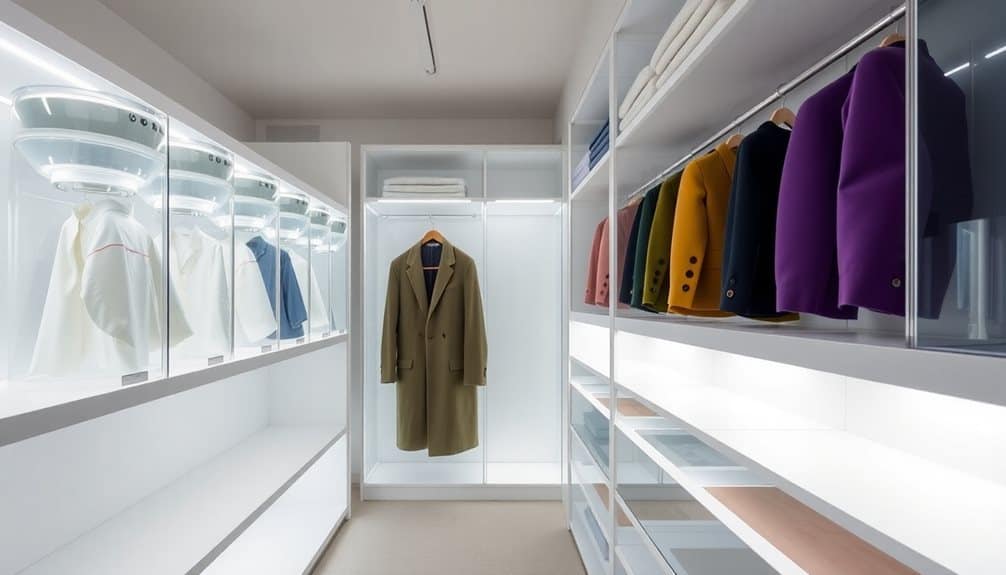
Transform your closet into a tech-enabled storage sanctuary with next-generation solutions designed for 2024. Install smart clothing rods that track your wardrobe usage patterns and automatically rotate seasonal items to the front when needed. Implement humidity-controlled storage pods that preserve delicate fabrics and prevent moisture damage during long-term storage.
Maximize your space with AI-powered compression units that vacuum-seal off-season clothing while monitoring fabric integrity. You’ll need to connect these units to your home’s smart system through the standard clothing care app. Install motion-activated LED strips that illuminate specific zones as you reach for items, reducing energy waste and helping you locate pieces quickly.
Consider adding RFID-enabled hangers that sync with your virtual wardrobe inventory, letting you track item location and wear frequency. Mount climate-controlled drawer systems that maintain ideal storage temperatures for different fabric types. Don’t forget to set up the automated garment freshening station – it’ll use UV light and ionic cleaning to keep stored items fresh without harsh chemicals. These solutions work together through your home’s central AI, creating a fully integrated storage system that anticipates your seasonal needs.
Assessing Your Current Wardrobe

Before implementing any high-tech storage solutions, you’ll need to take stock of what’s actually in your wardrobe. Start by removing every item and sorting them into distinct categories: seasonal wear, year-round basics, special occasion pieces, and workout gear. Document each piece using your smart device’s inventory app for future reference.
Evaluate each item’s condition and relevance to your current lifestyle. Check for signs of wear, missing buttons, or broken zippers. Set aside items that need repairs or alterations. You’ll want to note which pieces you’ve worn in the past 12 months and which ones no longer fit your body or style preferences.
Create a digital inventory spreadsheet with key details: size, color, fabric composition, care instructions, and frequency of wear. Tag items that are part of capsule collections or coordinate well together. This data will help you identify gaps in your wardrobe and prevent duplicate purchases.
Measure your available storage space and calculate how much room you’ll need for each category. This assessment will guide your decisions about which storage solutions to implement and help you determine if you need to pare down your collection.
Consider using storage cubes to maximize vertical space while keeping your clothing easily accessible and visible.
Creating Climate-Adaptive Clothing Zones
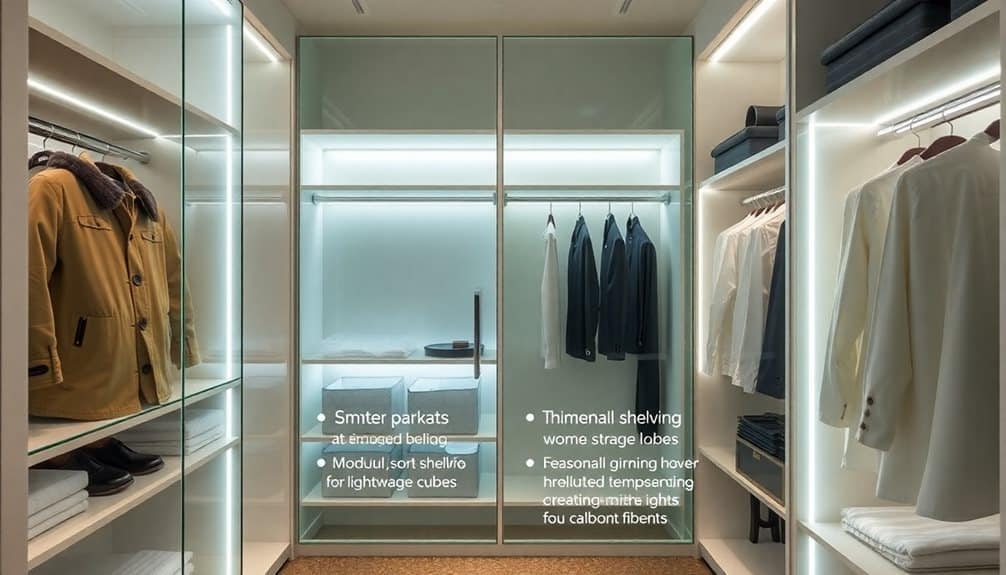
Three distinct climate zones within your home serve as the foundation for an effective seasonal clothing storage system. Your primary zone should be your everyday closet, maintaining a stable room temperature between 68-72°F with 50% humidity for current-season clothing. Create this zone in your bedroom’s main closet using a basic dehumidifier and adequate ventilation.
Your secondary zone, suitable for next-season items, requires a cool, dry space between 60-65°F. Convert a spare closet or dedicated armoire in a less-used room, employing moisture-absorbing packets and cedar blocks to maintain prime conditions. You’ll need to rotate these items quarterly as seasons change.
Your long-term storage zone, perfect for off-season clothing, demands the most controlled environment. Set up this zone in a basement storage room or climate-controlled attic space, maintaining temperatures between 55-60°F with 40% humidity. Install a programmable dehumidifier and use airtight storage containers with silica gel packets. Label each container clearly with contents and season, and position them away from exterior walls to prevent temperature fluctuations that could damage delicate fabrics.
Digital Wardrobe Management Tools
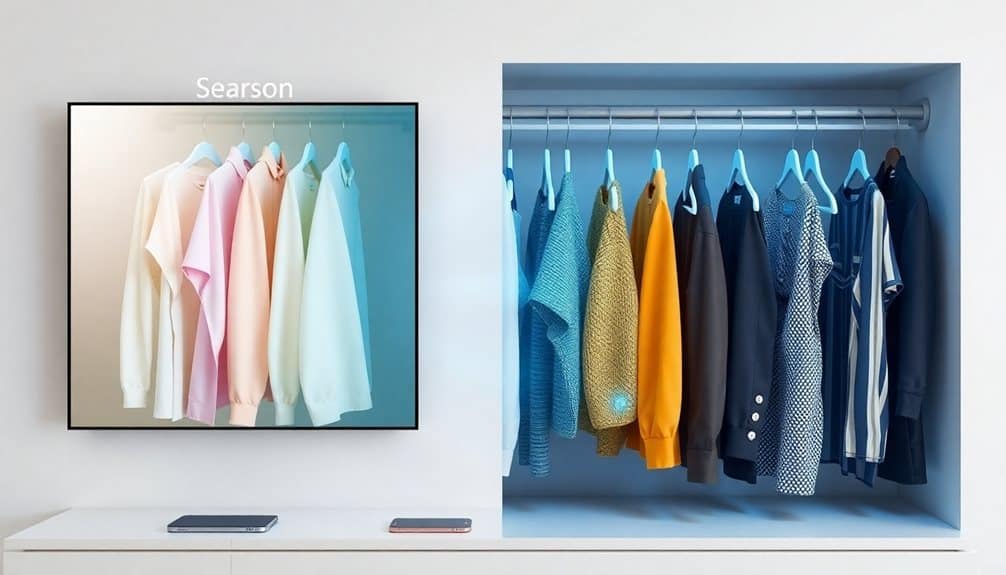
While physical organization creates the foundation of your seasonal wardrobe system, modern apps and digital tools can streamline your clothing management process. You’ll find specialized wardrobe apps that let you catalog items with photos, track wear frequency, and plan outfits based on weather forecasts. Popular options like Stylebook and Smart Closet offer features for creating digital inventories and seasonal rotation schedules.
To maximize these tools, start by photographing each clothing item against a neutral background. Tag items with relevant details: season, fabric type, care instructions, and purchase date. You’ll want to utilize the apps’ analytics features to identify which pieces you wear most frequently and which ones remain unused. Many platforms now integrate with smart hangers and RFID tags, automatically updating your inventory when you remove or return items.
Set up automated notifications for seasonal switches, cleaning schedules, and maintenance reminders. You can also sync these tools with your calendar to suggest appropriate outfits based on upcoming events and weather conditions. Most apps now offer cloud backup, ensuring your wardrobe data remains secure and accessible across multiple devices.
Space-Saving Packing Techniques

Maximizing storage space starts with mastering efficient packing techniques. You’ll want to begin by rolling your clothes instead of folding them flat, as this method reduces wrinkles and creates compact, easy-to-store bundles. For sweaters and delicate items, use the file-folding method, storing them vertically like books on a shelf for easy access and visibility.
Vacuum storage bags are essential for bulky winter items like coats and comforters. You’ll reduce their volume by up to 75% while protecting them from dust and moisture. When packing shoes, stuff them with smaller items like socks or accessories to maintain their shape and utilize dead space.
Use compression cubes to separate clothing categories while maximizing vertical space. Stack these cubes using the pyramid method: heavier items at the bottom, lighter ones on top. For hanging items, try the cascade hanger method, where multiple garments hang from a single point using chain-linked hooks. Don’t forget to use door-mounted organizers and under-bed storage containers to capitalize on often-overlooked spaces. Label everything clearly with seasonal tags for quick identification when it’s time to rotate your wardrobe. For additional vertical storage, install a double-rod system that can support up to 33 pounds of clothing while effectively doubling your closet space.
Hybrid Wardrobe Transition Strategies

Creating a hybrid wardrobe helps you adapt to unpredictable weather patterns between seasons without massive closet overhauls. Start by identifying your core layering pieces – lightweight knits, adaptable jackets, and versatile bottoms that work across temperatures. Group these items centrally in your closet for easy access during seasonal shifts.
Implement a rolling change system by gradually moving 25% of your current season’s clothes to storage every two weeks as you approach the next season. Replace them with appropriate items from the upcoming season, maintaining a balanced mix of both. Keep multipurpose items like cotton cardigans, lightweight scarves, and adjustable-sleeve shirts in constant rotation.
Organize your closet in temperature zones rather than strict seasonal categories. Place year-round basics at the center, with progressively warmer or cooler pieces radiating outward. Use removable closet dividers to adjust these zones as needed. Convert portions of drawers into flexible storage by using adjustable dividers, allowing you to expand or contract space for seasonal items. This system lets you maintain a functional wardrobe that’s ready for temperature fluctuations while maximizing your storage efficiency.
Preservation Methods for Off-Season Items
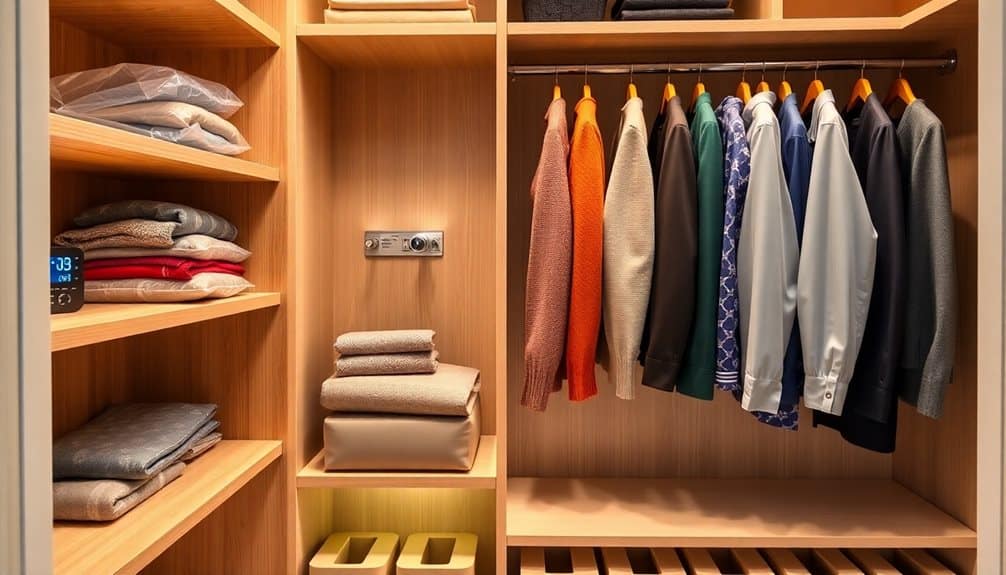
Proper storage techniques can extend the life of your off-season clothing by years. Before storing any garments, verify they’re clean, completely dry, and free from stains that could set permanently during storage. You’ll need acid-free tissue paper, breathable cotton storage bags, and cedar blocks to create ideal preservation conditions.
- Pack delicate items like cashmere and wool sweaters with tissue paper between folds to prevent permanent creasing. Don’t hang these items, as they’ll stretch out of shape over time.
- Use vacuum storage bags for bulky items like winter coats and comforters, but avoid compressing natural fibers like silk and wool, which need air circulation to maintain their structure.
- Store leather goods and shoes with moisture-absorbing silica gel packets and cedar inserts to prevent mold growth and maintain shape.
Keep your stored clothing in a cool, dry place away from direct sunlight and heat sources. Avoid plastic containers, which can trap moisture and lead to mildew. Check your stored items every few months and refold them to prevent permanent creases. If you detect any musty odors, air out the items immediately and address any moisture issues in your storage area.
Sustainable Clothing Rotation Systems

Smart clothing rotation systems help you maintain a sustainable wardrobe while reducing waste and extending the life of your garments. You’ll need to establish a four-season rotation schedule that aligns with your local climate patterns and lifestyle needs. Create designated changeover periods between seasons where you’ll evaluate, clean, and switch out clothing items.
Implement a “one-in-one-out” rule when adding new pieces to your wardrobe. Before storing off-season items, photograph and catalog them in a digital wardrobe app to track wear frequency and identify redundant pieces. Use clear bins with climate-controlled storage solutions, and label everything by season and category.
Set up a quarterly review system to assess each item’s condition, repair needs, and continued relevance to your lifestyle. Track which pieces you’re actually wearing using a hanger-facing method: turn hangers backward at the start of the season, and only return them to forward-facing after wearing items. Items that remain backward-facing after two seasons should be considered for donation or resale. Maintain a digital inventory of your capsule wardrobe for each season, including care instructions and purchase dates.
Frequently Asked Questions
How Do I Handle Clothing With Sentimental Value That I Rarely Wear?
Create a dedicated “memory box” for your cherished clothing items. You’ll want to clean each piece thoroughly, wrap it in acid-free tissue paper, and store it in a climate-controlled space. If you’d like to preserve the memories while freeing up closet space, take photos of the items and consider displaying one or two special pieces as wall art.
What’s the Best Way to Share Closet Space With a Partner?
Start by dividing the closet into clear zones for each person, using color-coded hangers or physical dividers. You’ll want to establish shared spaces for common items like formal wear or seasonal gear. Don’t forget to utilize vertical space with double hanging rods and door-mounted organizers. Schedule regular decluttering sessions together, and create a system for handling shared laundry duties. Keep communication open about space needs and adjustments.
Should I Keep Clothes That No Longer Fit but Might Again?
Don’t keep clothes that don’t fit unless you’re actively working toward a specific size goal within the next 6-12 months. If you decide to store them, limit yourself to a single storage bin and label it with a target date. You’ll feel better donating items that aren’t serving you now, and you can always buy new clothes when you reach your goal size.
How Often Should I Rotate Hangers to Prevent Clothing Damage?
You’ll want to rotate your hangers every 3-4 months to prevent permanent creasing and fabric stress. Shift your garments’ positions on the rod, and turn hangers 180 degrees to distribute weight evenly. For delicate or heavy items, rotate them monthly. When rotating, inspect each hanger for damage, replacing any bent or broken ones immediately. This practice helps extend both your clothing’s life and the hangers’ durability.
When Is the Ideal Time to Buy Storage Solutions for Seasonal Changes?
You’ll find the best deals on storage solutions during end-of-season clearance sales. Buy winter storage items in March-April when retailers discount cold-weather merchandise, and summer storage solutions in September-October. Plan your purchases 2-3 weeks before you’ll need them, taking advantage of major retail sales events. Don’t wait until the season changes, as prices typically rise when demand peaks.



